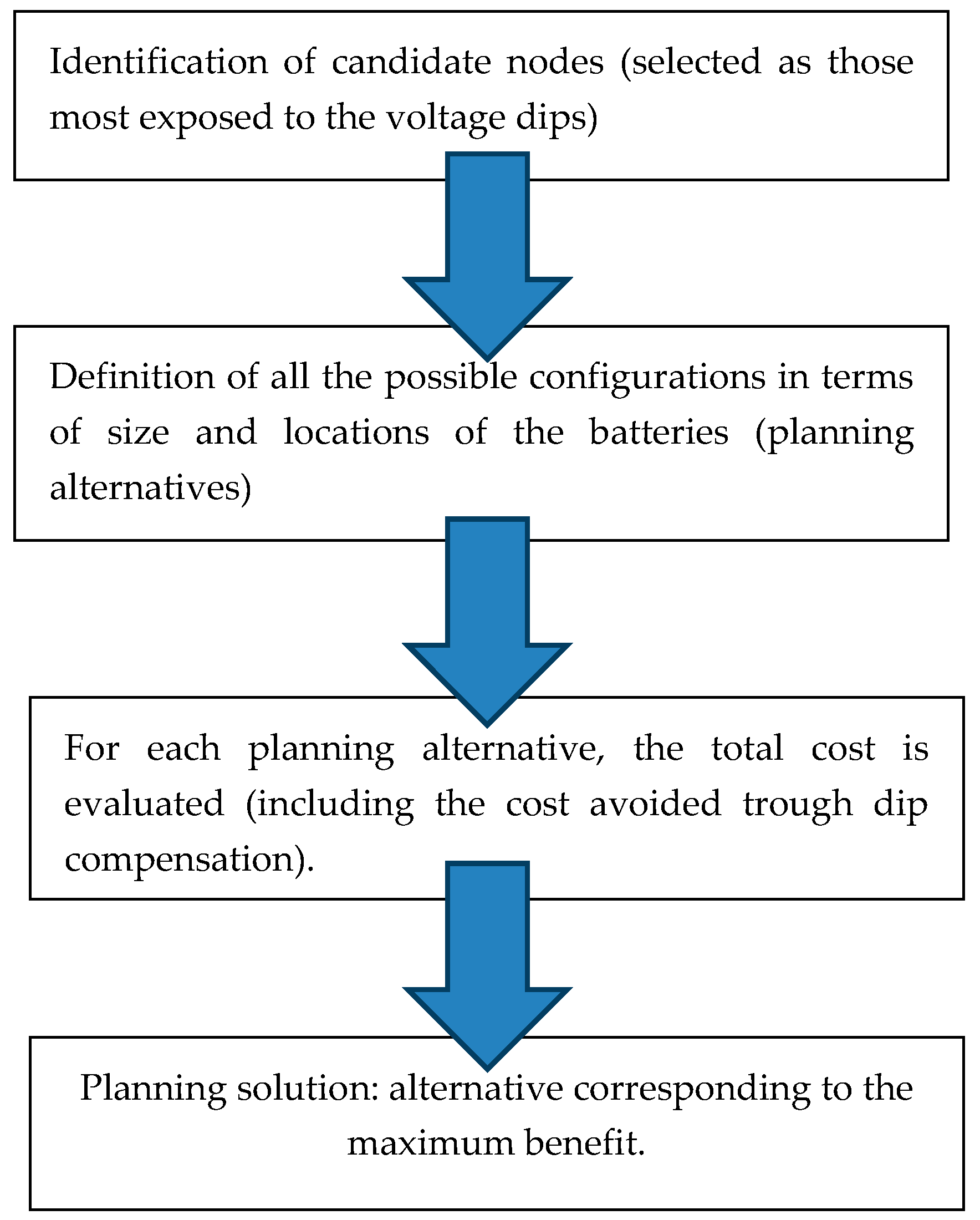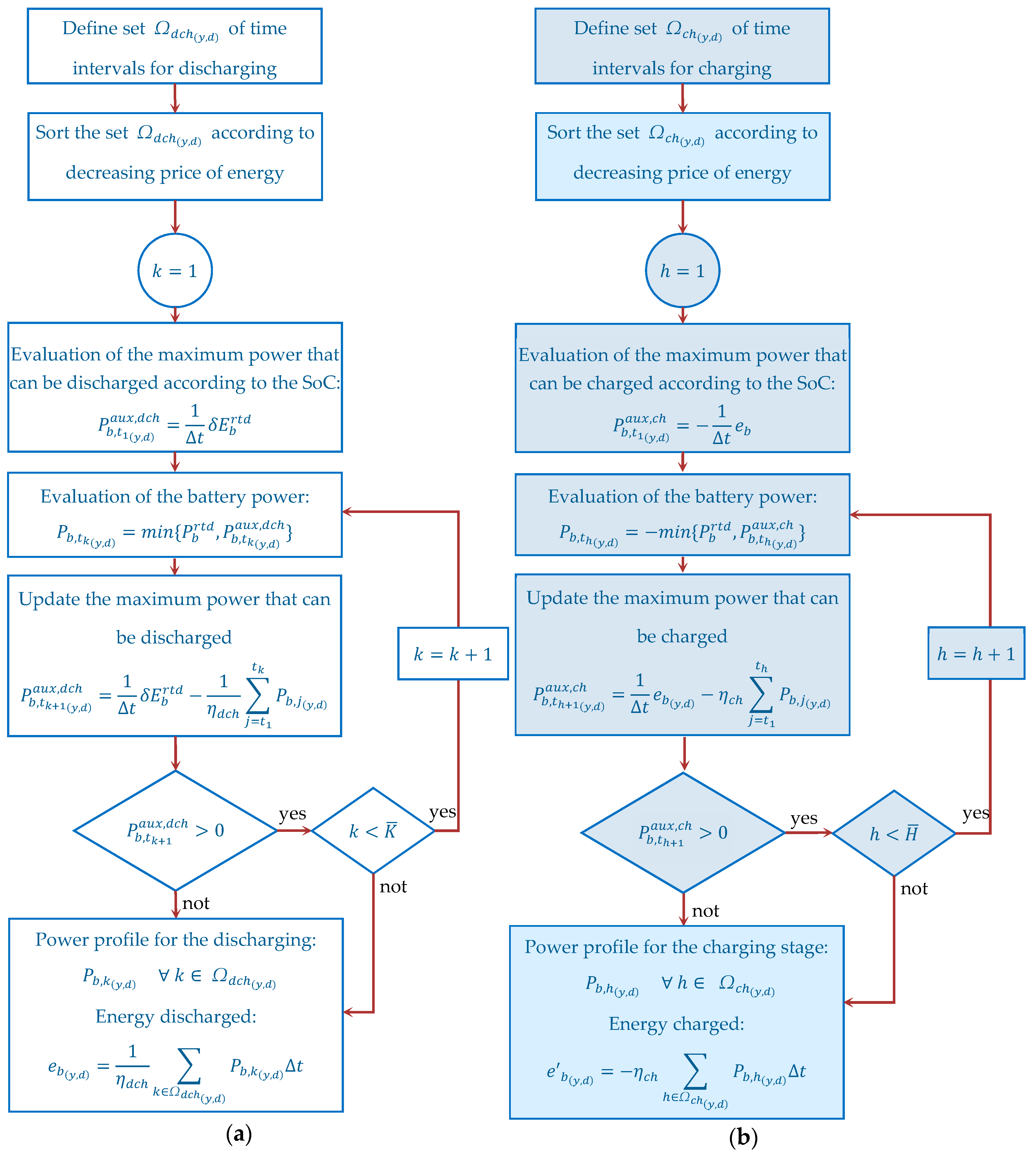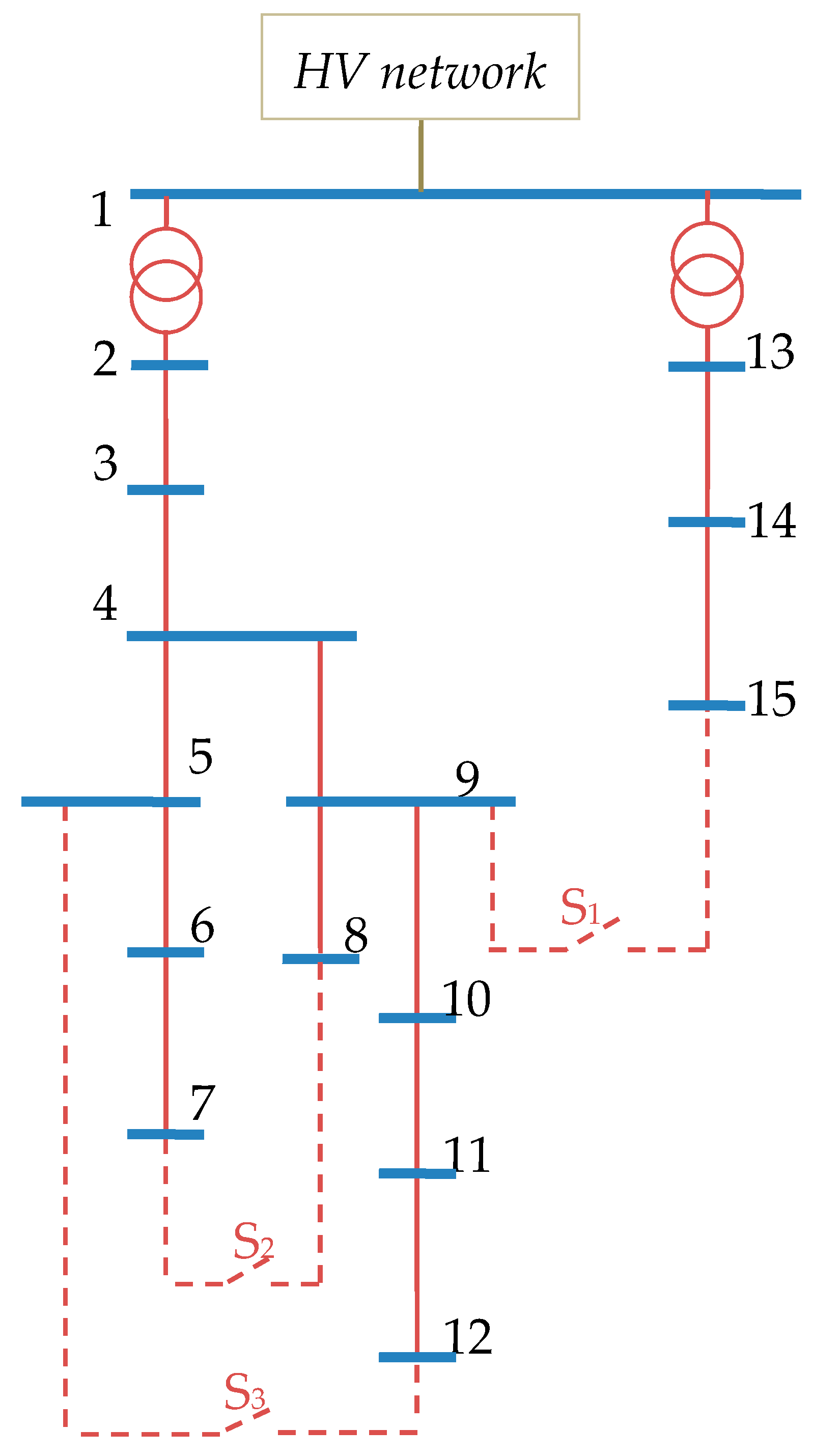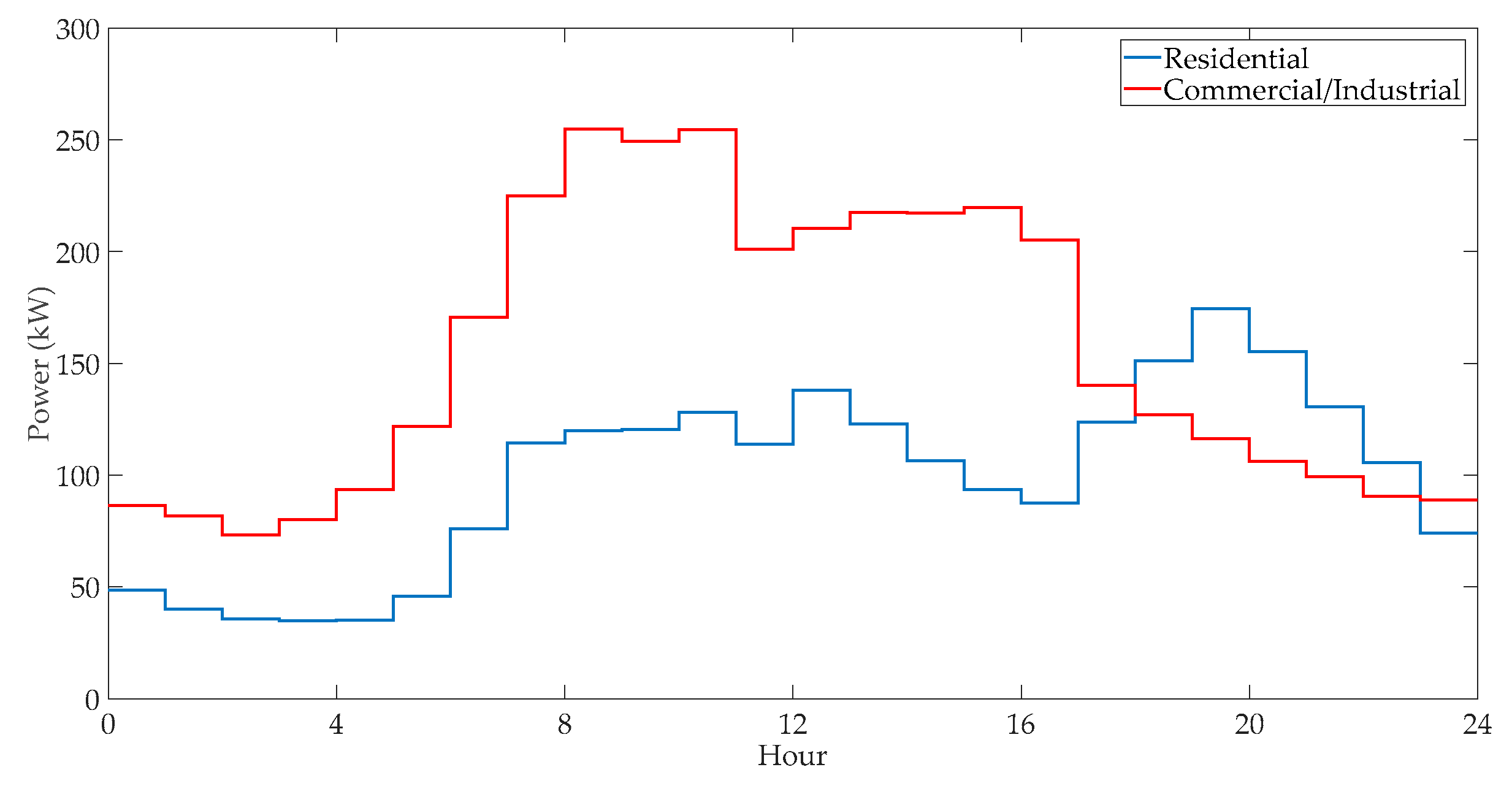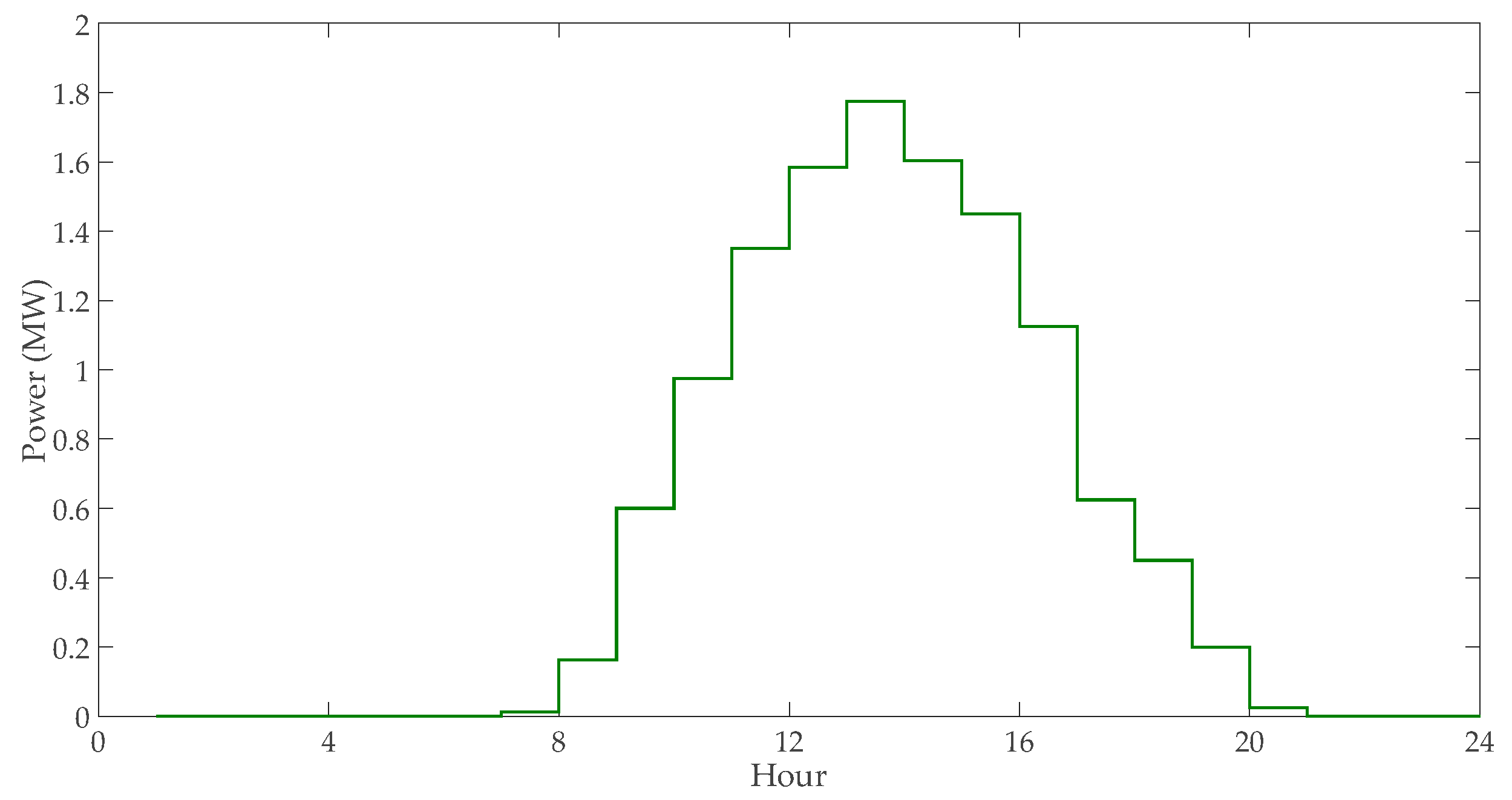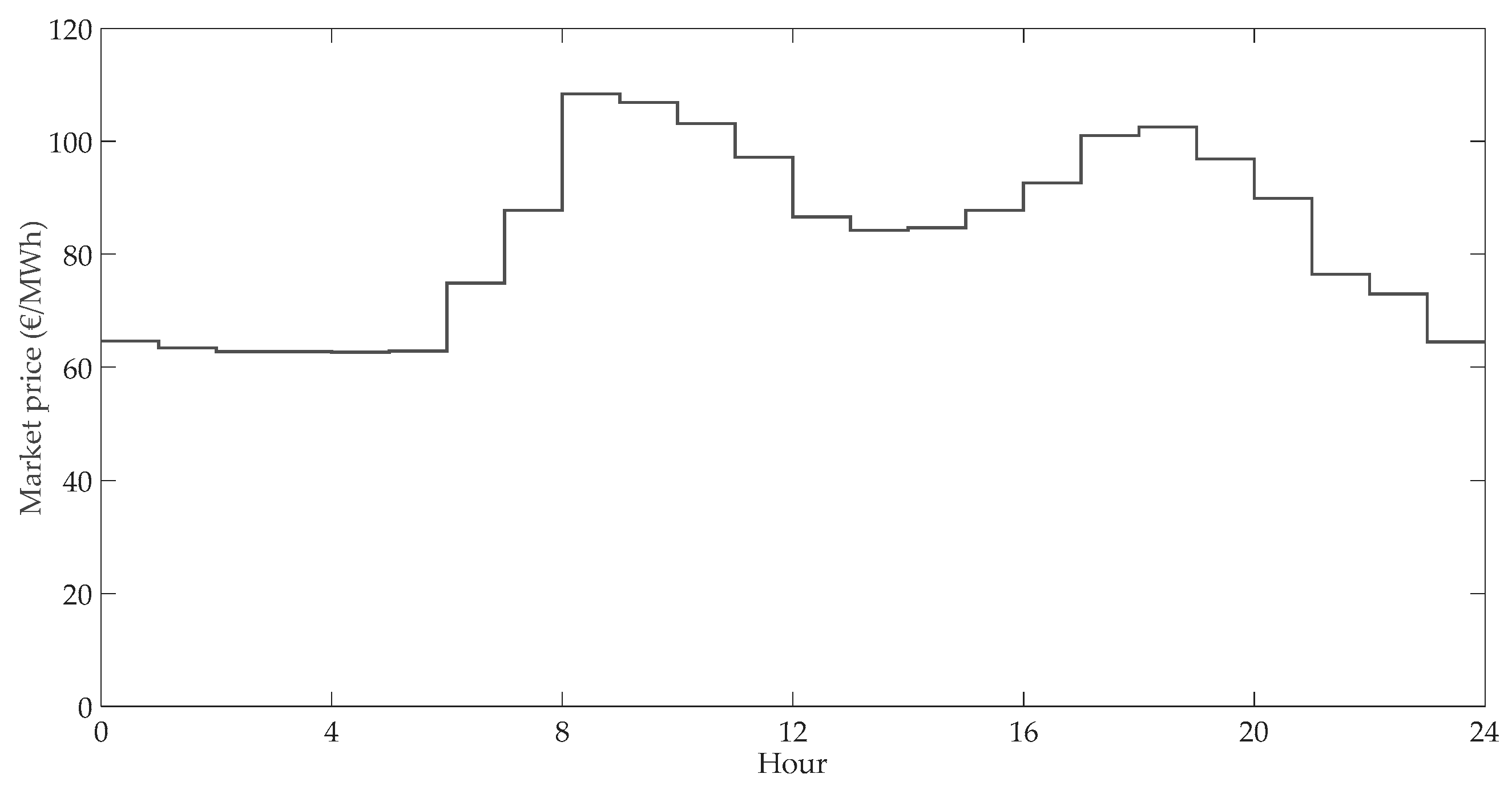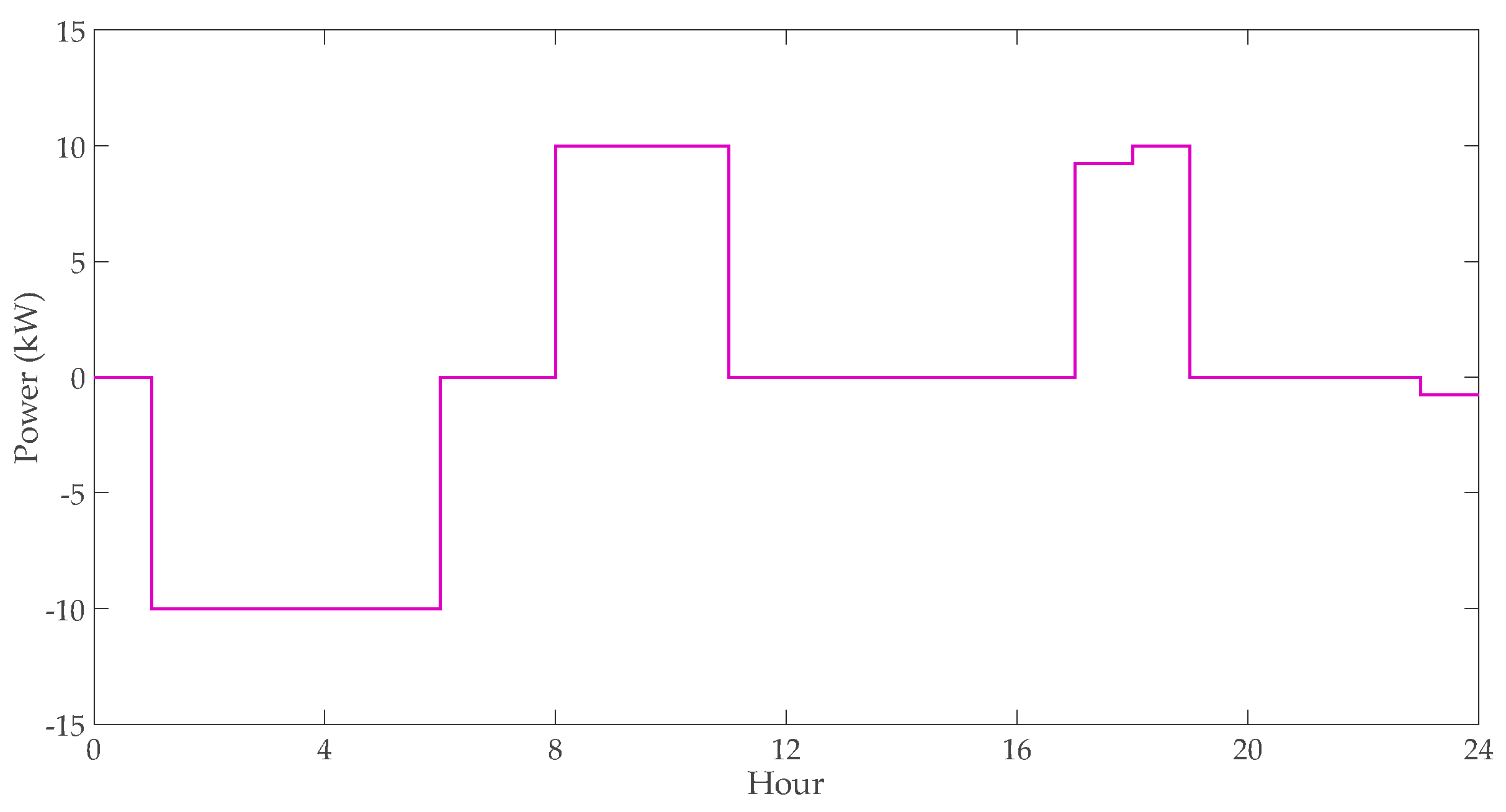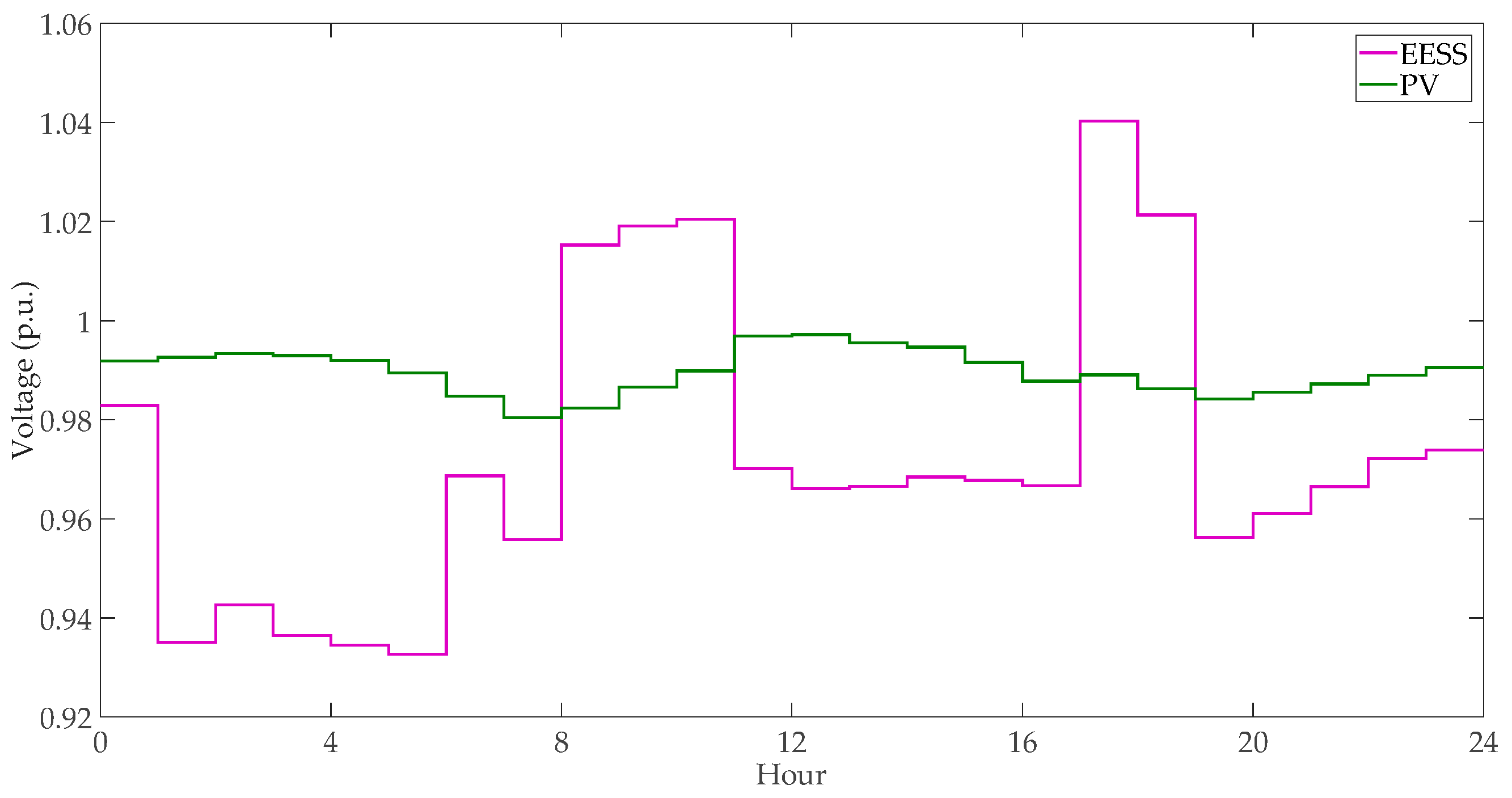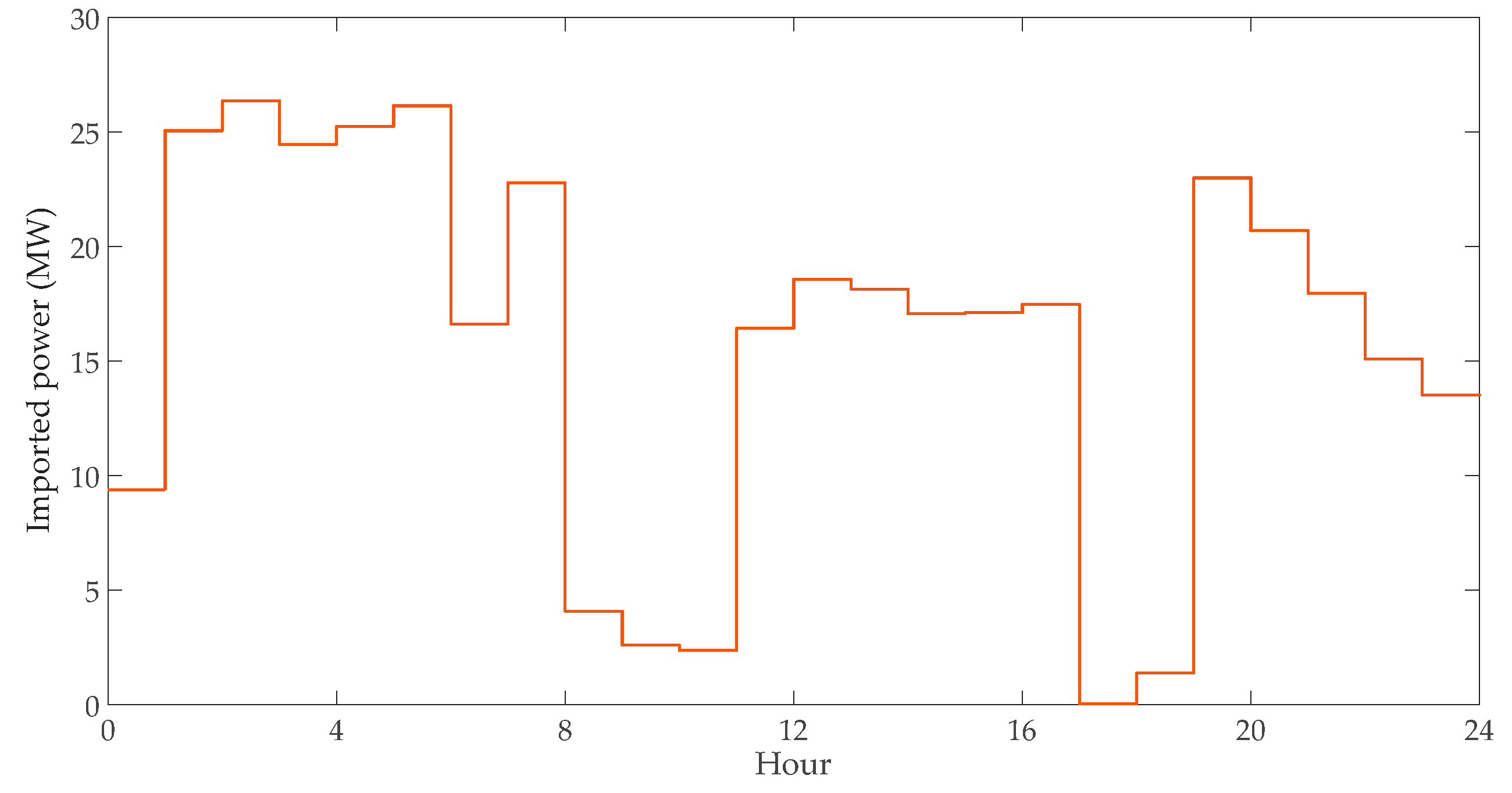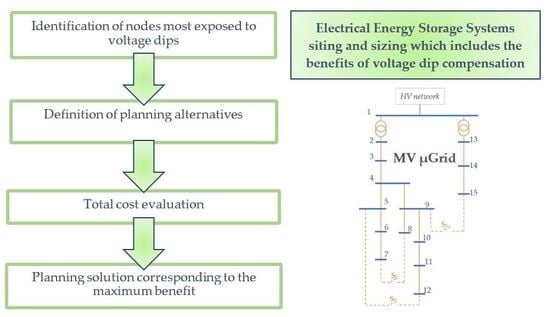All the cost items refer to the whole planning period and are detailed in the following sub-sections. In (5), maintenance cost can be also added as a percentage of the installation cost. For ease of notation, in the following equations, the reference to alternative is omitted.
4.3. Operation Cost
The operation cost of the µG refers to the cost of the energy imported from the upstream grid. It is supposed that the µG is not able to sell energy to the upstream grid. The cost of the energy imported implies the evaluation of the overall costs
- -
sustained by the µG’s owner to (i) supply the loads, (ii) charge the EESSs, (iii) compensate for the power losses;
- -
avoided thanks to the EESS discharged energy.
The planning time horizon includes
years, each represented by
typical days. Forecasted daily profiles of the power requested by the loads, of the power delivered by the distributed generation, and those of the energy price are known for each typical day of the first year. These profiles are known with reference to all the
time intervals—of duration
—in which each day is divided. The corresponding profiles for the subsequent years are evaluated based on a specified yearly growth. The operation cost for the whole planning period is then provided by the net present value of the sum of the costs sustained at each typical day:
where
is the discount rate,
is the number of days represented by the
dth typical day in the year
,
and
are the power imported from the upstream network and the energy price, respectively, at the
kth time interval of the
dth typical day of the year
.
In order to evaluate the power imported from the upstream grid, , a minimum cost strategy is formulated for the µG, on the basis of a two-stage procedure which allows decoupling the hourly optimization algorithm so reducing the computational burden.
In the first stage, the hourly active power of the EESSs is evaluated. According to the cost minimization approach, the value of the power of each EESS is derived by charging the battery during low-price hours and discharging it during the high price hours, while constraints are imposed on the rated power and energy capacity of the EESSs.
In the second stage an OPF is solved, at each time interval, with respect to the known variables (i.e., specified values of loads’ active and reactive powers and active powers of DG units and EESSs) and unknown variables (i.e., active and reactive power at the PCC, reactive powers of both DG units and EESSs.) Coherently with the cost minimization strategy, the OPF minimizes the power imported at the PCC while satisfying the constraints on both the µG and the interfacing converters.
a. 1th Stage: EESS Profile Optimization
The power that can be charged or discharged by the EESSs at each time interval depends on the stored energy available in the battery, on the rated power and on the price of energy corresponding to that interval. A this aim, two sets of time intervals are identified in a day: the first set is related to the highest price—where the EESSs can be discharged to reduce the costs of the imported power—
, the second set is related to the lowest price—where the EESSs can be charged—
. Two different iterative procedures are applied in
and
(
Figure 2).
The iterative procedure that applies to
allows obtaining the EESS’s profile during the discharging stage (
Figure 2a). The procedure is based on the identification of the time intervals included in
and on the identification of the set
which includes the time intervals of
sorted by decreasing price of energy. Then, at each time interval
tk included in
, with
, the power discharged by the battery is identified as the minimum between the EESS rated power (
) and the power corresponding to the battery SoC (
):
With reference to the first interval in which the battery can be discharged,
, it is assumed that the battery is fully charged, thus
where
is the rated energy capacity of the battery, and
is the admissible DoD. Once the battery power is known through (10), the power corresponding to the SoC is updated:
where
is the discharging efficiency of the EESS. The procedure ends when all of the time intervals in
are explored (i.e.,
) or
. Outputs of the procedure are the EESSs’ power profiles during the discharging stage (i.e.,
) and the total energy which can be discharged by the battery:
The iterative procedure, which applies in
allows obtaining the EESS’s profile during the charging stage (
Figure 2b). The procedure is based on the identification of the time intervals included in
and on the identification of the set
which includes the time intervals of
sorted by increasing price of energy. Then, at each time interval
th included in
, with
, the discharged power of the battery is identified as the minimum between the EESS rated power (
) and the power corresponding to the battery SoC (
):
With reference to the first interval in which the battery can be charged,
, it is assumed that the battery is empty, thus
where
is given by (13). Once the battery power is known through (10), the power corresponding to the SoC is updated:
Where
is the charging efficiency of the EESS. The procedure ends when all of the time intervals in
are explored (i.e.,
) or
. Outputs of the procedure are the EESS’s power profile during the charging stage (i.e.,
) and the total energy, which can be charged by the battery:
In order to make the strategy feasible, it is required that during each day, the energy charged and discharged must be the same:
In the case that (18) is not satisfied, the procedure for the discharging stage (
Figure 2) must be repeated by replacing
.
b. 2nd Stage: Optimal Power Flow
The Optimal Power Flow (OPF) in its general form is formulated as:
where the minimization of the objective function
is subject to equality and inequality constraints,
and
applied to the vector
of the optimization variables. Inputs of the OPF are the forecasted values of the power load demand, the DG power production, the energy price and the EESS power. Outputs are the reactive power of the DG units and of the EESSs, and the active and reactive power at the PCC. All these quantities are required to be known at all the
time intervals of each typical day
of year
. In order to minimize the operation costs defined in (9), the objective function is:
The constraints to be satisfied in the OPF include the classical power flow equations:
where
is the number of network buses and, with reference to the time interval
of the day
in the year
is the difference between the phase angles at nodes
and
,
and
are the active and reactive powers at bus
,
is the
bus voltage amplitude,
and
are the
-terms of the matrices of the conductance and susceptance, respectively. Constraints (25) and (26) refer to slack bus (
), that is the PCC.
The active and reactive powers in (19) and (20) include the powers absorbed by the loads, the power charged/discharged by the EESSs and the power produced by the DG units.
The active and reactive power exchanged at the PCC must comply with the transformer rate,
, that is:
The same applies to the power flowing through the converters interfacing the EESSs and the DG units, which cannot exceed the converter rated power,
:
where
has been previously derived in
Step 1,
is the EESS reactive power, and
and
are the DG active and reactive powers,
and
are the sets of buses, where the EESSs DG units are connected, respectively.
Further constrains refer to the limits imposed to the bus voltage and line current magnitudes:
being
and
the minimum and maximum voltage magnitude values,
the current flowing through the
lth line of the set
of network lines, which cannot exceed the maximum value,
(i.e., line ampacity).
In this case, the 2nd stage does not converge due to constraint violation, it will be iteratively applied by reducing the EESS contribution (i.e., by reducing ), till convergence is reached.
4.4. Cost of Voltage Dips
The cost of the voltage dips is strictly connected to the economic value the effects of the voltage dips have on the equipment’s and the operating processes or the activities. The most critical effect of the voltage dips is the trip of the device that is subject to the dip. The economic value of this detrimental effect represents, in turn, the cost of the voltage dip, and depends on the function of the device into the process or activity, the type of the process or activity, the linkage of the process in case stopped with other processes of the same production line, in case of industrial manufacturing loads, or with other operative functions, in case of loads different from manufacturing industries.
Generally, the cost of the voltage dips is the sum of three main components: direct, indirect and hidden costs [
23]. The direct costs relate to the interruptions of the specific device or equipment. They include, for example, lost work, lost production, damaged equipment; the indirect costs include the investment costs sustained by the end user to prevent or to solve the damages due the interruptions caused by voltage dips. Finally, the hidden costs account for any second level effects that reflect on the performance of the business, such as retaining customers, satisfying customers, and protecting the company’s reputation. The hidden costs in some studies are included inside the indirect costs [
26].
The cost of the voltage dips can be estimated by means of direct methods or indirect methods.
The direct methods are analytical methods that require at least the availability of the voltage dips measured at the load site, the deep knowledge of several characteristics of the devices or equipment (dip susceptibility curve, operating mode, functional linkage of each device with other devices of the same equipment, and of the same process, structure and topology of the electric lines feeding each device and equipment), and the detection of the areas of the process exposed to the stoppage. They are usually conducted as after-the-fact-case studies of the events of voltage dips occurred at a specific site [
26,
27,
28]. A direct method can also use the voltage dips expected at the site feeding the sensitive loads obtained by means of the simulation of the electric system in short circuit conditions. The two main methods available and widely used are the fault position method (FPM) and the critical distance method (CDM). The most adequate method to use depends on several parameters, as reported in the comparative study of [
8]. Whichever of these methods obviously requires the knowledge of the electrical system feeds the load sites.
The indirect methods estimate the cost of a disturbance without passing through the analytical quantification of the effects of that disturbance on specific devices or equipment’s. They can use macroeconomic analysis [
11] or surveys of the customers asked to directly estimate their suffered costs due to the supply disturbances or to provide qualitative economic figures of the electric supply linked to that disturbance. In the case of the supply interruptions, for example, the National economic regulation of continuity in Italy started with an extensive survey aimed to estimate two indices: the willingness to pay (WTP) and the willingness to accept (WTA) [
29]. WTP measures the additional price of the electric service the users would pay for avoiding the interruptions; WTA instead measures the amount of money they would accept for having to experience the outage. These indices allowed fixing the incentive rate for the penalties and the rewards in the first regulatory scheme of the National Authority of electricity ARERA, formerly AEEG [
30].
The existence of the economic regulation of a disturbance could solve the problem of establishing the costs for the loads, especially in the planning activities with long-term horizons, as in the case of this study. In such cases, in fact, the specific details of the loads are not obtainable and would not be reliable to assign them.
Unfortunately, no economic regulation of the voltage dips is still active [
31]. However, some preliminary studies [
32,
33] offer valuable figures resulting from measurements, survey and simulations, which can guide in deriving the economic value to assign to the voltage dips.
In this paper, we referred to [
32] where the authors analyzed the economic and technical data collected for a number of medium-voltage (MV) industrial users that participated in the cost assessment project and the monitoring campaign. In particular, the authors used an indirect method based on a monitoring-and-survey approach to estimate the direct costs faced by a large variety of industrial customers. As detailed in the paper, the costs were presented both as annual value per kW and as event value for kW, with the latter independent from frequency. In this paper, we used the event value per kW of the installed power of the load.
For the evaluation of the total costs of the voltage dips over a long-time horizon, the frequency of occurrence of the voltage dips must be evaluated. The annual frequency can be estimated in average from data measured on real systems. In this paper, we referred to the measured data on the MV Italian National Grid (with reference to year 2016) at the MV busbars of the HV/MV substations (
Table 1) [
34].
Finally, the cost related to voltage dips over the planning period,
, can be evaluated as:
where
is the number of busses sensitive to the voltage dips,
is the planning time horizon (years),
is the discount rate and, with reference to the voltage dip belonging to the residual voltage class,
rv,
is the cost suffered by the customer due to the single event of voltage dip at the year
,
is the number of the voltage dip events at year
, and
is the set of residual voltage classes which the voltage dip event refers to (i.e., first column of
Table 1).
is the power value to be considered for the dip cost identification, with reference to the user connected to the
ith bus of the µG at year
. In this paper, we referred to the load nominal value.
We assumed that the EEC units compensate only to voltage dips at the node where the EES is installed. This assumption is very cautious, since the beneficial effects of the compensating action can be wider, involving also further nodes electrically close to the installation node of the EES. With structures of the network other from radial, the detection of the area, in which the voltage dips are compensated by the EES installed in one node, requires the simulation of the system in short circuit conditions with EES acting as voltage dip compensating unit. A FPM, applied in the presence of the EES, giving as result the propagation of the voltage dips for short circuits in every node of the system, could allow obtaining this result.
